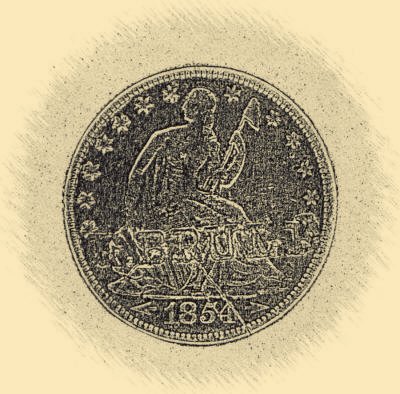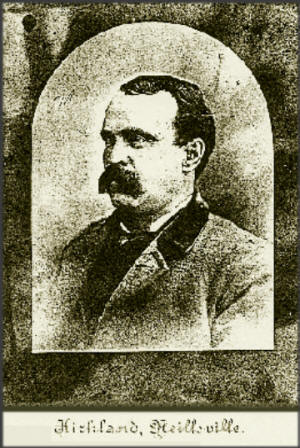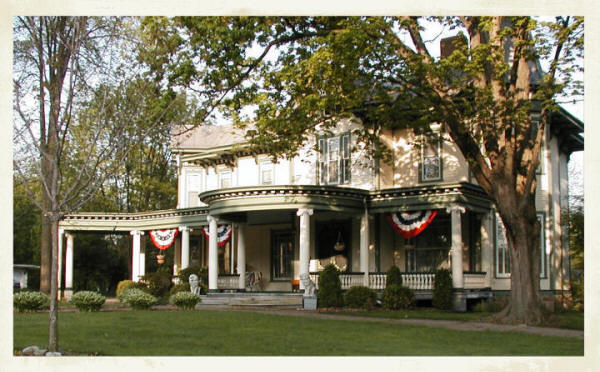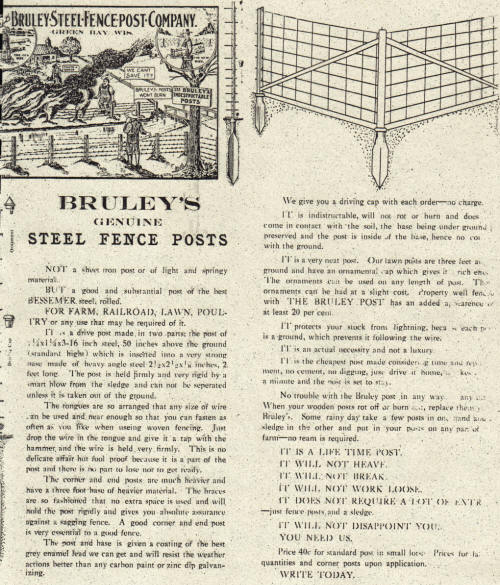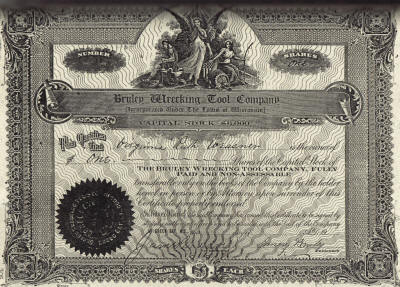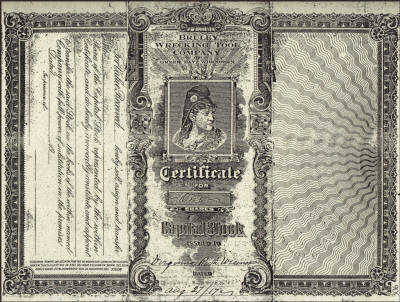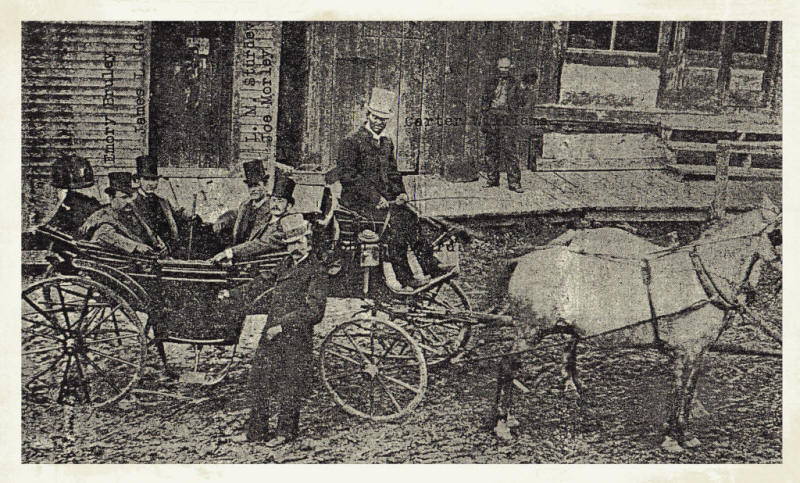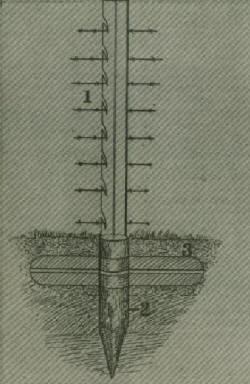Bio: Bruley, Emery & Mary Philomene Bachamp
Contact: Stan
----Source:
Barbara Benware Burt,
Wiesner
Surnames:
Brule’
1843 - 1928
Emery’s grandparents,
Parents & their families
& much about Emery Brule’ himself & his
family Emery
Brule’s half-dollar with "Bruley" stamped on it.
This was from Cousin Phyllis (Wiesner)
Choura’s memorabilia Emery Bruley was a logger,
blacksmith, merchant and inventor who resided in Neillsville, WI. This
picture came from a family collection owned by the Benware and Barton
family. The notation on the bottom places it in Neillsville, WI, having been
the work of Kirkland Photos. The photographer could well have been Charles
B. Kirkland who died in 1882 and is buried in the Neillsville City Cemetery
which would place the time frame of the picture previous to that. If you
have any information which could lead to a greater understanding of who this
individual may be, please contact
Barbara Benware Burt .
Notice that was beneath Emery’s photo: J. H. Crowns, Artist, Neillsville, Wis. Negatives preserved for one year. Duplicate Copies 25 cents each. A large assortment of Frames, Album, Stereoscopic views and Scopes on hand. - Pictures copied, enlarged and finished in India ink and water colors.
××××××
Emery Brule’s Grandparents, Parents, their families and his family
Emery’s grandparents Alexis Brule’ and Genevieve Thomas married in Rigaud, Quebec Province, Canada on 10 February 1812. Rigaud is almost on the border of Quebec Province and Ontario Province. Alexis had apparently moved south from where he grew up, probably in search of a better job. He and Genevieve raised a family of seven known children. Available Church records confirm the baptism of most of their children took place in Rigaud. Like father, like sons - records confirm that two sons - Thomas and Edouard - moved south to Ottawa and away from their parents. Each married a young woman with the surname of Brunet and who were cousins. When Edouard died an early death, his widow and children lived with Thomas and his family.
Alexis Brule’ and Genevieve Thomas had seven known children who were:
VICTOIRE BRULE’ b. 4 Dec 1812, bp 5 Dec 1812
DENISE BRULE’ b 7 Oct 1814, bp 4 Dec 1814
THOMAS BRULE’ bp 4 May 1816 (Emery’s father)
m 19 Oct 1840 (1) Angelique BRUNET in Ottawa, Ontario, Canada
d 30 Sep 1858 Ottawa
m 26 Dec 1858 (2) Elmire Bedad
d 18 Mar 1891, Ottawa
JOSEPH BRULE’ b 3 Jun 1818, bp 7 Jun 1818
MARIE SERAPHINE BRULE’ b 4 Sept 1820, bp 5 Sep 1820
XAVIER BRULE’ b?
EDOUARD BRULE’ b?
m 1 -7 -1846 Zephirine Brunet
d 15 Nov 1851, Ottawa, Canada
Emery’s father THOMAS BRULE’ married ANGELIQUE BRUNET, the daughter of JOACHIM BRUNET in Ottawa Cathedral 19 October 1840. They were of Bytown (old name for Ottawa) in Carlton County, Ontario, Canada.
Thomas Brule’ and Angelique Brunet had seven known children who were:
SOPHIE BRULE’
Bp 6 Sep 1841, Bytown, Canada
M 28 Aug 1861 JOSEPH PELLETIER
EMERY BRULE’
B 4 Jul 1843, Bytown, Canada
M (1) 29 Sep 1862 PHILOMENE BEAUCHAMP, Bytown, Canada
M (2) 24 Aug 1886 Margarette McGinnis, Neillsville, Wisconsin
D 20 Feb 1928, Green Bay, Wisconsin -- Buried St. Mary’s Cemetery, Neillsville
MARIE ------- BRULE’
Bp Dec 1847, Bytown, Canada
D 6 Jan 1848, Bytown, Canada
THOMAS BRULE’
Bp 1849, Bytown
M 23 Oct 1869 EMMA LOYER
MARIE CHRISTINA BRULE’
Bp July 1852, Bytown
JOSEPHINE BRULE’
B?
M? JOSEPH DESISLETS
EDWARD BRULE’
B Aug 1853, Bytown, Canada
M 1876 MARY CAMPBELL, Neillsville, Clark Co. Wisconsin
D 19 Apr 1902, Neillsville, Wisconsin -- Buried At. Mary’s Cemetery, Neillsville
Emery Brule’ (Bruley) & Margarette "Maggie" McGinnis & their four daughters
ANITA MAE (SOPHIE MARY) BRULE’ (Bruley)
B 8 Apr 1888, Neillsville, Clark Co., Wisconsin
M 1912 to Joseph Franklin Wiesner
D 25 Jun 1978, Illinois
Their daughters: Virginia, Jean Chamberlain, Phyllis Choura
MAUDE ELIZABETH BRULE’ (Bruley)
B 15 Nov 1889, Neillsville
M 15 Nov 1912, Milwaukee, Milwaukee Co., Wisconsin to Philip Henry Griffin
D 16 Feb 1972 Ladysmith, Rusk Co., Wisconsin
Their daughter: Jane O’Connor
RUTH LUCILLE BRULE’ (Bruley)
B 31 Jan 1891, Neillsville
M (1) 1917 to Winfred Cyril Dittmer (no children)
M (2) 8 Oct 1920 to Noble Brown Ritchey
D 29 July 1974 Greenwood, Johnson Co. Indiana
Their daughter: Joan Knox (compiler of this Brule’ Bruley family history)
MARIE BLONDINE EVANGELINE BRULE’ (Bruley)
B 6 Oct 1899, Neillsville
M 30 Nov. 1922 to William Thomas Bracken (no children)
D 27 Jun 1988 Beloit, Rock Co. Wisconsin
××××××
These are their stories
1840 THOMAS BRULE’, son of Alexis and Genevieve married ANGELIQUE BRUNET, daughter of JOACHIM BRUNET, in Ottawa Cathedral on 19 October 1840. His brother Edouard attended the ceremony and later married Zephirine Brunet, daughter of Janvier Brunet. Recent research by Carol Ann Turner identified the Brunet girls as cousins and found Thomas’ parents and grandparents. Thomas was classified as ‘laborer’ not a blacksmith. We have no information when Thomas left Rigaud for Ottawa. Thomas was apparently astute enough to realize this and became a blacksmith as did his son Emery.
1843 Emery Brule’ was born on the fourth of July, 1843, in Bytown, Carlton County, Ontario, Canada. Today Bytown is knows as Ottawa, but the other place names have not changed. When Emery married in 1886 he said his father was THOMAS BRULE’ and his mother was SOPHIA CARIERS. I have never come across the name ‘Cariers.’
1851 According to the 1851 census of Canada, Emery’s father Thomas, a blacksmith, was born in Montreal around 1815 (Actually Rigaud, per church records). Thomas with 8 year-old Emery, 10 year-old Sophie, and 3 year-old Thomas lived in a two-story log house on property which measured 33’ x 99’. Sophie Burnet, 25, is listed as married and a family member.
Living in the house with Thomas and his wife are Zepphirine Brunet, a 20 year old widow with Heloise Brule’, 4, Evina Brule’, 2 and Theodosia Brule’, age 1. Zepphirine was Thomas’ brother Edouard’s widow. He died in 1851 before the census was taken. Baptismal records show Edouard and Zepphirine had children as follows: Zepherine who was born on 20 March 1848 and baptized on 2 April 1848; Maria Theodosie, baptized 2 January 1852. Theodosie would die in February or March of 1854. Evina [Hevina?] also died in early February or March 1854. These are not listed as family members. All were Roman Catholics.
The census apparently lists married women by their maiden names. Angelique Brunet was also called Sophie. In the 1851 census she is Sophie Brunet and is shown as 25 thus she was only 14 or 15 when she married Thomas! Perhaps this wasn’t as surprising for the times as the 20 year old widow who also lived with the family had a 4 year-old child, thus would have married at 15.
My cousin Phyllis (Wiesner) Choura, daughter of Anita (Brule’) Wiesner, wrote in February of 1982 that when her mother turned 65 and applied for Social Security she discovered, in her records that her name was really Sophie Mary! Sophie Burnet (Angelique) was named as a married family member of Thomas’ household in 1851; we know Thomas named his first daughter Sophie. Mother told me her father Emery was very fond of his mother, and thus may well have added Sophie to his first daughter’s name.
1853 Ten years after Emery was born, his brother Edward was born in Ottawa on 10 August 1853. Grandfather’s sister Josephine is not listed in either the 1851 census or the 1861 census so I cannot estimate her birth year. I believe I have a date for Josephine’s marriage to Joseph Desislets. On film LDS #1571038 from Carol Ann Turner, on what appears to be an index card, Joseph and Josephine’s names are listed along with the date of ‘1874 - 6/6.’ Mother recalled the couple lived first in Great Falls, Montana and then in Seattle. Joseph was much older than Josephine. He was a skilled piano finisher by profession. His recipe for furniture care was to wash with Ivory soap, rinse well, follow with vinegar/water rinse, then dry and wax. Their two sons were remembered as Claude, a pharmacist in Portland, Oregon, and Irving. Mother said her Aunt Josephine had pure white hair and was a nurse. She was tiny and very meticulous. Josephine and her son Claude were in Neillsville at the Brule’ home when Dede was born. By that time Josephine was a widow. She spoke French as fluently as her brother Emery.
Aunt Dede said when Emery was a young man he played an E flat cornet in the Ottawa City Band. The King of England was to visit to Ottawa, and the band was to play. The king disliked the French. Emery, who was French Canadian, did not want to welcome the king. He and a like-minded friend intentionally blew their horns ahead of time, and were promptly dismissed from the band. In a snit, Emery threw the cornet down the well, remarking "Here’s your darn parrot." What his comment meant I don’t know. The cornet belonged to the band so I wonder if Emery later fished it from the well. Emery also said he’d come home late more than once, been locked out, and climbed down the chimney.
1858 Angelique (Sophie) Brule’, Thomas’ wife and the mother of his children, died on 30 Sep 1858. She was only 40 years old. Thomas Brule’ married ELMIRE BEDAD on 26 Dec 1858 at St. Paul d’Aylmer Church at Aylmer, Quebec. Emery would have been about 15, Thomas 10, Edward 5. In those years men often remarried quickly as, unless willing relatives lived nearby, there was on one to look after the children, and the men needed to work to feed their families.
1861 In the 1861 Canadian census Emery is shown as a 17 year-old blacksmith living with his father and stepmother in a larger house. The family had moved from a log house to one of frame. The property measured 53’ x 70’. Edward was 7; Zirephin who may be Josephine was 5 and Olivia 3, Olivia presumably was the child of Thomas and his wife Elmire. Ottawa directories for 1861-1862 show Thomas Brule’, a blacksmith; living on St. Patrick Street between Dalhousie and Sussex.
Sophie was the first child to marry. She wed Joseph Pelletier on 28 August 1861 at Notre Dame Cathedral in Ottawa. Both my mother and Aunt Dede believed the Pelletiers lived in Green Bay, Wisconsin.
1862 Nineteen year-old Emery Brule’ married Philomene Bachants/Beauchamps at Notre Dame Cathedral on 29 September.
1866 The young couple was shown as living at 45 Clarence in Ottawa in the 1866-1867 Directories per researcher, Jade Belyea. Emery, like his father, was a blacksmith. In those directories Thomas Brule’ lived on the north side of Park Street in Ottawa. I assume this is Emery’s father as Emery’s younger brother Thomas would have been only 18.
Both my mother and Aunt Dede were aware that Emery did not care for his stepmother Elmire. He was probably anxious to live away from her.
1868-1869 Emery and Philomene left Canada in 1868. The write-up in the 1881 Clark County history says of Emery "…in 1868 went to Minneapolis, Minn., and afterwards to La Crosse, where he met Mr. Stafford and came up with him to Staffordsville, in 1868; came to Neillsville and started a blacksmith shop, which ran for 9 years, then opened a clothing store."
Emery’s younger brother Thomas married Emma Loguer/Loyer on 23 October 1869 at Notre Dame Cathedral in Ottawa.
Emery’s uncle Joseph (Eustache) came to Neillsville after Emery settled there. The families may have been close in early days, but apparently not in later years.
1870 The census for Neillsville shows Emery as a 23 year old blacksmith who was born in Canada West. Philomene is his 21 year old wife, also born in Canada West. Real estate: $500; personal estate $150, Emery’s younger brother Edward is not shown, thus I assume he was still in Canada.
Mother said her father was a most patriotic American, and his birth date was quite appropriate for his adopted country. Emery filed his "Declaration of Intent" to become a citizen on 5 November 1870 with the office of the Neillsville Clerk of Circuit Courts. However, he, like many others, did not file what were called "second papers" which would have made him eligible for citizenship. He may well have thought he filed all that was needed to become a citizen of the United States as he definitely believed he was.
1873-1874 Meanwhile back in Canada; I believe it is Emery’s brother Thomas who appears in the Ottawa city directories as a grocer with a hotel at 128 Sussex in Ottawa. Mother said her Uncle Tom had a hotel in Ottawa.
1876 Someplace along the way, youngest brother Edward followed Emery to Neillsville. In 1876 he married Mary Campbell.
1869-1878 Neillsville - the site of Emery’s blacksmith shop during these years.
1880 Emery was in the clothing store business in Neillsville. He said his store stock was valued at $9,000 and his annual business ws $25,000. Per the census, 35 year-old Emery ‘keeps clothing store.’ Both his and Philomene’s parents were Canadian-born.
Brother Edward and wife Mary are also in the 1880 Census. They have 3 year-old Hannah L., and one year-old Mary Elizabeth. I assume Hannah L. was the Leah who married Isaac Stockwell. Mary Elizabeth (know as Mate) was later the wife of Levy Williamson. Ida, not born by 1880, eventually was the bride of Dr. Warren Bradbury. Louis was the Williamson’s only child; the Bradbury children were Mary Elizabeth who married Samuel Groseclose; Robert and Philip.
1883 Businessman Emery was listed in Dun & Bradstreet. Aunt Dede had a copy of that issue, but loaned it to a friend who lost the volume. Surprisingly, Dun and Bradstreet records do not go back as far as 1883.
1885 This is the year Philomene and Emery planned and built a new eight room home. But Philomene, his wife of twenty-three years, died on 24 April. Whether she died before the house was completed or was too ill to move into the new home or if she actually lived in it at the time of the death we do not know. We do know some time before August of 1886 when Emery married Margarette "Maggie" McGinnis, he and Richard Dewhurst traded houses. Emery and his bride would live in the former Dewhurst home.
Almost one hundred years after Emery and Philomene’s home was built it became a museum.
Tufts Museum - Neillsville, Wisconsin
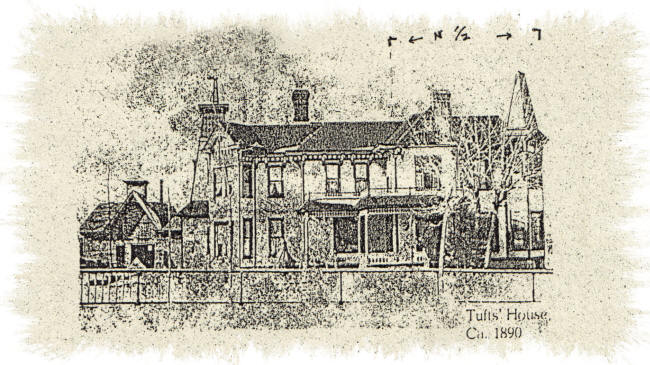
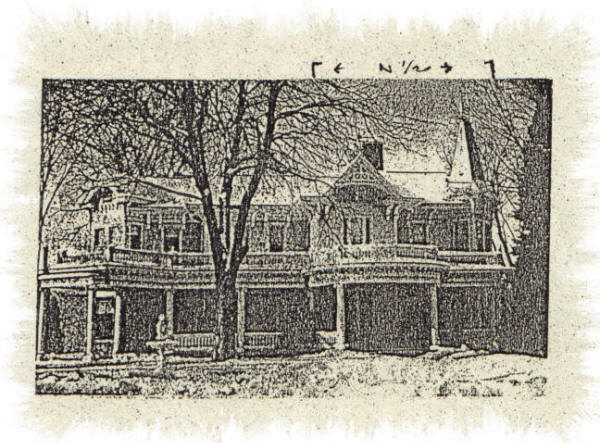
The grand opening of the Tufts Museum was held on 25 June 1983. Under "Recollections in their program brochure it reads:
Little did Emery Bruley realize when he built the original Tufts house in 1885 that he and future occupants would experience such a fantastic period of growth in the community and the country… The house as it stands today reflects the changes of that period as well as the personalities of each succeeding generation of owners.
The house was built in two sections. The north half, built by Bruley (a blacksmith, inventor, and prominent businessman) still contains the original plate glass windows with their etched, brilliant cut glass borders and the identifying initial "B."
The brochure tells about subsequent owners. We know Emery traded the house to Richard Dewhurst, a pioneer citizen, first Neillsville lawyer, lumberman, state legislator, and founder of the Neillsville Bank. Dewhurst added the larger section to the south with matching by windows, well house with windmill and a small porch. At this point in time, the house with its angles, gingerbread, iron cresting, corbels and turret looked decidedly Victorian.
Indoor bathroom facilities, including a built in six foot copper bathtub, were thought to be the first in the area. This was a convenience for guests only. A carriage house-stable was added with space for as many as seven driving horses and two cows.
The first photograph shows the house around 1890 before Dewhurst added the elegant colonial portico with Greek ionic columns, now giving the house the Colonial or Classical Revival style.
Richard Dewhurst died in 1895. His daughter Mary and her husband William Hemphill became tenants of the house that Mary inherited when her mother died in 1922. Hemphill was a banker; both he and his wife served as president of the Neillsville Bank.
After Mrs. Hemphill died in 1958, the house was owned until 1961 by Mr. and Mrs. Robert Stoll who sold the home to Colonel and Mrs. William B. Tufts. Tufts descended from early Wisconsin pioneers, served in World War I and was on General Douglas MacArthur’s staff in World War II. The Tufts did extensive remodeling, adding a graceful divided stair way, combining two sitting rooms, and installing beautiful crystal chandeliers. Tufts died in 1963 before the renovation was completed. Mrs. Tufts completed the project and moved into the house in 1965. She filled the home with fine antique furniture, oriental rugs, and mementos of her extensive travels. She and her husband had planned years before that the home would become a historical museum. When she died in 1982 Jennie Tufts willed the house to the city of Neillsville.
In August of 1983, Aunt Dede, Cousin Jane O’Connor, and I were able to visit the Museum. We were graciously received and overwhelmed by the beautiful house. I had heard about the initial "B" etched in the front windows of the house. I regarded this decoration as suspect (read ‘ostentatious’) until I saw the actual windows. The eight-inch border of each window is etched with deer, flowers, and other pretty designs. The "B" is beautifully done at the center of the top border. The windows are absolutely lovely as are the house and grounds. Emery would be proud. His descendants who visit the museum will also be proud.
1886 It was to the former Dewhurst home that Emery brought his bride Margarette (Maggie) McGinnis after their marriage on 24 August 1886. Grandmother and Grandfather Brule’ married at a Presbyterian service performed by Neillsville pastor Rev. W. T. Hendren as the Catholic Church had not come to Neillsville. Agnes McGinnis and Mary E Bruley represent both bride and groom’s families as witnesses.
1888 Anita Mae a.k.a. Sophie Mary joined Emery and Maggie on 8 April 1888. Phyllis has the lovely baby portrait of her mother done in pastel by an artist from Marshall Field of Chicago. Anita married Joseph Franklin Wiesner, also of Neillsville, in 1912. They became the parents of Virginia Ruth born 14 December 1913, Margaret Jean on 3 March 1917, and Phyllis Marie on 18 September 1919. Jean became the wife of Kenneth Chamberlain in 1938. Phyllis and Frank Choura married in 1945.
1889 Maude Elizabeth was Emery’s and Maggie’s second child. Born in Neillsville on 15 November 1889, as an adult she married Philip Henry Griffin 15 November 1912. Their daughter Jane was born 12 February1918. Jane married Richard J. O’Connor in 1942.
1891 Ruth Lucille, the third child, arrived on 31 January 1891. She married first young attorney Winfred Cyril Dittmer of Seymour, Wisconsin in 1917. He died from mastoid infection six months after their marriage. She married Noble Brown Ritchey of Franklin, Indiana on 8 October 1920. They were my parents. I was born 26 February 1924 and married John J. Knox in 1952.
Not long after Mother’s birth, her grandfather Thomas died in Ottawa, Canada on 18 Mar 1891. He was 75. A Canadian researcher could find no obituary for Thomas. Per family tradition, Emery was in charge of settling his father’s estate. No probate for Thomas’ estate was filed per 1983 correspondence from the Archives of Ontario. Although he disliked his stepmother, he supposedly saw to it that she inherited Thomas’ lead mine.
That elusive lead mine, if it existed, has been impossible to locate because no one knew the name of the mine. Without the name the Canadian authorities cannot locate it. After much research, I have concluded perhaps Thomas owned stock in a lead mine and those shares were what Elmire received. The Kingdon mine at Galetta on the Ottawa River, near Amprior, Ontario, also near Ottawa, was an early producer, briefly active in the 1880’s, then reactivated in 1914 and operated until early 1930’s.
1893 At the Chicago World’s Fair grandfather bought a German sewing machine, complete with display cabinet. Part of the lower cabinet was turned into a handsome desk which Phyllis has; drawers from the upper part were turned into small cabinets by Aunt Dede and these I enjoy. I also have a large Victorian mirror; from my Brule’ grandparents home.
1894 The lovely house that Emery and Philomene built didn’t attract nearly as much local attention as the House that Emery Built in 1894!
There are differing stories about the exact reason Emery built the second house, but the end result is the same. My mother’s version: Emery had a row of trees in the front of his yard. The trees were parallel to the street. He was very proud of these trees which were either maple or black walnut. There was a wooden sidewalk that followed the row of trees but was closer to the street.
The town constable announced the street was to be widened. Grandfather had no problem with this until he learned his wooden sidewalk would be moved inside the row of trees and closer to the house. Emery said he would have the sidewalk inside his tree row. The constable waited until Grandfather was out of town. Grandmother awoke one night to find lanterns lighting the front yard, and a crew of men busily moving the wooden sidewalk inside the row of trees. When Grandfather returned to Neillsville, he was furious.
He quietly approached the owner of a lot which adjoined the constable’s. This lot was 25 feet wide and very deep. Emery bought the lot. Zoning laws were not in place back then. Emery promptly had a house built that was exactly 25 feet wide and quite long. It was designed with a large front room and a long hallway with rooms coming off the hallway. He then had the house painted bright red! Emery rented the house free or for a nominal charge to anyone who gave music lessons or who had many children. The house was directly in the constable’s view and hearing. When asked how the house got there, emery said he guessed a cyclone brought it. "Cylone" became its name forever after. Both the constable and Emery had been blacksmiths in the early days; may have been more to the story than just the sidewalk.
1899 Marie Blondine Evangeline was the youngest child of Emery and Maggie. She was born 6 October 1899. Her two older sisters were each allowed to choose a name for her. You can tell which names appealed to preteens Anita and Maude. As an adult, Marie married William Thomas Bracken on 30 November 1922 at La Crosse, Wisconsin. They had no children of their own, and were very fond of their nieces.
1900-1905 The census for 1900 gives Emery’s occupation as ‘spoke manufacture.’ He was 56, Maggie 37, Anita 12, Maude 10, Ruth 8, and Marie seven months old. Martha Wagner was a live-in helper.
Mother said her father manufactured spokes for Studebaker wagons. He invented a way to put metal rods in the center of each spoke, thus a much stronger wagon wheel could be produced. She told me had had one spoke factory; then built another in a better location where the logs could come down the river. I believe there was a factory at Cadott, Wisconsin and/or Neillsville. I think he had a partner in the spoke business. Aunt Dede said Emery also owned a ginseng farm with Pat Molloy as manager.
Emery’s much younger brother Edward died on 19 April 1902. Mother told me her Uncle Edward did not want nails in his coffin and Emery made certain wooden pegs were used. Mother wrote, "Uncle Ed was a dear - could entertain a group of youngsters by the hour. He had a small farm right in Neillsville. It had a pretty house and beautiful lawn. I was ten when he died and heartbroken."
It was in 1904 when Emery patented his first two metal fence posts. The following year he formed the Bruley Steel Fence Post Company of Milwaukee, Wisconsin. Family tradition says these metal fence posts were used along the Green Bay and Western Railroad right of way. Louis Jorgenson, a brother-in-law, was an executive with the railroad.
Aunt Dede recalled Shell, Boat & Boyd, a Milwaukee manufacturing company, wanted to produce, market and distribute the fence post under their name and pay Emery a royalty. He preferred to have his own name on the post, which turned out to be an unfortunate choice as presumably Grandfather did not have the capital to proceed as the established company would have had. The metal fence post was a clever, needed invention.
Grandfather is said to have held 14 patents which included fence posts, a wrecking bar, and railroad crossing signals with flashing lights. I checked patents prior to 1898 and these were not among them. The only later patents checked are Emery’s for his three styles of fence posts patented in 1904 and 1905. The drawings for these patents are not quite the same as the fence post actually produced and sold. If the posts were made as late as World War I the company would soon have been unable to get the needed steel.
••••••••••
(click to enlarge)
BRULEY’S
GENUINE
STEEL FENCE POSTS
NOT a sheet iron post or of light and springy material.
BUT a good and substantial post of the best BESSEMER steel, rolled.
FOR FARM, RAILROAD, LAWN, POULTRY or any use that may be required of it.
IT is a drive post made in two parts; the post of 1 1/4x1 1/4x 3/16 inch steel, 50 inches above the ground (standard height) which is inserted into a very strong base made of heavy angle steel 2 1/2x2 1/2 x 1/8 inches, 2 feet long. The post is held firmly and very rigid by a smart blow from the sledge and can not be separated unless it is taken out of the ground.
The tongues are so arranged that any size of wire can be used and near enough so that you can fasten as often as you like when using woven fencing. Just drop the wire in the tongue and give it a tap with the hammer and the wire is held very firmly. This is no delicate affair but fool proof because it is a part of the post and there is no part to lose or to get ready.
The corner and end posts are much heavier and have a three foot base of heavier material. The braces are so fashioned that no extra space is used and will hold the post rigidly and gives you absolute assurance against a sagging fence. A good corner and end post is very essential to a good fence.
The post and base is given a coating of the best grey enamel lead we can get and will resist the weather actions better than any carbon paint or zinc dip galvanizing.
We give you a driving cap with each order - no charge.
IT is indestructible, will not rot or burn and does not come in contact with the soil, the base being underground is preserved and the post is inside of the base, hence no contact with the ground.
IT is a very neat post. Our lawn posts are three feet above the ground and have an ornamental cap which gives a rich effect. The ornaments can be had at a slight cost. Property well fenced with THE BRULEY POST has an added appearance of at least 20 per cent.
IT protects your stock from lightning, because each post is a ground, which prevents it following the wire.
IT is an actual necessity and not a luxury.
IT is the cheapest post made considering tiem and replacement, no cement, no digging, just drive it home, takes a minute and the post is set to stay.
No trouble with the Bruley post in any way, anyhow. When your wooden posts rot off or burn off, replace them with Bruley’s. Some rainy day take a few posts in one hand and a sledge in the other and put in your posts on any part of the farm - no team is required.
IT IS A LIFE TIME POST
IT WILL NOT HEAVE
IT WILL NOT BREAK
IT WILL NOT WORK LOOSE
IT DOES NOT REQUIRE A LOT OF ENTRY-- just fence posts and a sledge.
IT WILL NOT DISAPPOINT YOU
YOU NEED US.
Price 40c for standard post in small lots
Prices for large quantities and corner posts upon application
WRITE TODAY!
¤¤¤¤¤¤¤¤¤
Undated events but probably prior to 1910
How do you pronounce Brule’?
The family name of Brule’ is pronounced Broo-lay. In Wisconsin Emery grew tired of hearing it pronounced Brool so he added ‘ey’ to the name and then people pronounced more nearly correctly. He was proud of his name, and liked to see ‘E. Brule’ or ‘E. Bruley’ stamped on metal items. I saw this on a table fork Aunt Dede kept. She said he stamped his name on many things. Phyllis gave me an 1854 half dollar with ‘E. Brule’ firmly stamped on it.
Entertainment choices
Emery was a great movie fan, and always sat in the same seat. He also thought séances were frauds, but never missed a chance to attend one. If a séance was held in the area, he hopped on the train and went. As the spirits at the séance were being ‘materialized’ and flying through the air he would grab them. This broke up several séances. He broke up another by asking for and receiving a written message supposedly from a dead relative. Grandfather told the séance conductor he was a fraud as the message was written in English and the relative could only write French.
Christmas Eve
Emery would buy all the unsold toys in the store and take them home for his daughters. Before he had children, he is said to have bought French wax dolls for a niece and also given her a hammer as well as the dolls. (By this time Emery’s brother Ed lived in Neillsville where he’s married and had children.)
Health Scene
Emery gritted his teeth as he slept. Mother said the nose rattled the windows. Gritting his teeth may have contributed to the loose teeth he eventually experienced. Undaunted, he designed a gold wire apparatus, had the dentist install it, and kept his teeth.
When he had bursitis or arthritis in his upper arm, he heard of a Minneapolis spiritualist who could heal people. Off he went. The spiritualist told him if he would think to himself that his arm didn’t hurt the pain would go away. This seemed to be the total of her treatment. He asked what he owed. She repeated she was sure if he would concentrate and think his arm didn’t hurt that it wouldn’t, but she didn’t seem to have helped him so she would charge him only a dollar. Emery put a fifty cent piece on the table and prepared to leave. "My good man," the spiritualist said, "My charge is a dollar." Grandfather replied, "Well, think it’s a dollar."
Favorite sayings
"He’s so two-faced he has to look at his feet to see which way he’s going."
When a person did not want to comply, he/she had "a pain between the heart and the will."
Early hi-tech and lessons taught
Emery had one of the first cars in Neillsville in around 1903. Aunt Dede recalled it as an air-cooled Franklin. The car seemingly had a chain drive which broke with alarming regularity. When the chain broke, Emery abandoned the car and walked rapidly away from it. He had nothing to do with the car until a mechanic repaired it and delivered the car to the house. Emery taught Mother to drive. After the rest of the family was asleep, they would go to the barn where the car was garaged, push it out to the street, and away they would go. After she learned to drive Mother would chauffeur business people to the spoke mill at Cadott.
He also had one of the first phones in Neillsville.
Emery apparently had little faith in the stock market at the time he gave Mother a dollar to buy stock in a company he knew was faulty. She lost her dollar, and never again had anything to do with the market. He must not have followed this program with Aunt Dede who, as an adult, was very interested in the market. Emery taught Aunt Dede to drive nails straight and true. He sat her down on a wooden step, armed her with nails and a hammer; taught her to pound and pound she did until she was quite proficient. She also learned when in the lower grades if she stopped by her father’s clothing store at noon, he would give her a nickel to spend.
Consumer goods and the social scene
Emery must have enjoyed clothes as he was in the clothing business at two different times in his life. He once had a very elegant tuxedo-front full length fur coat. The outside was seal with an otter collar. The inside was lined with natural mink. Aunt Dede was quite explicit about the details. She said it was made by Hanson of Milwaukee, probably a well-known furrier of the day. Once when on a train, a stranger asked Grandfather who had made the coat and how much it cost. He replied he’s earned it selling Rumford Baking Powder.
Jane O’Connor recalled being told that Mr. H. L. Gates of Milwaukee, a friend of Grandfather’s, had his own private railroad car and that Grandfather often traveled with him. When they went to New Orleans, Grandfather would have a barrel of oysters shipped to Neillsville. He then had his annual oyster party - with men only as guests. Emery felt only grandmother, not the maid, could fix oysters perfectly. The dinner began with oysters on the half-shell; then proceeded to fried oysters.
Aunt Dede reported the junior-senior high school prom was often held at their house.
Emery frequently went to New York on business. While there he would buy china by the barrel. Whenever the pantry could hold no more dishes, a wheelbarrow load was delivered to whomever wanted some new-to-her dishes. He also bought toilet tissue in huge cartons. A large, sturdy, ornate Victorian walnut table with many leaves was also shipped from New York to Neillsville. When Grandmother Brule’ broke up housekeeping, Mother and Daddy acquired the table. [This table is a bear to dust.] John’s and my daughter Linda was fascinated by the fancy turnings on the table when she was very small; Mother said the table was to be hers eventually. It now shows off advantageously in Linda’s home.
Love of animals
Emery loved animals. He once had a pair of pet squirrels who had their own special bed with a silk coverlet. Emery tucked the squirrels in every night. When Wisconsin winter turned very cold, he used the second floor of a building he owned as a refuge for wild animals. The windows were opened or removed (memory leans to ‘removed’), trees were set up, and plenty of food was made available. (How the animals knew to come in is beyond me, but come they must have.)
Once when Grandmother was having a large luncheon party - a popular entertainment of the day - she was horrified to discover a big branch complete with bird’s nest and eggs nailed to the living room mantle! Grandfather had found a fallen limb on the ground. He did what he thought needed. I do not know if the branch and its contents remained as a conversation piece for the party.
Grandfather had a pet raccoon he adored. At some point the ‘coon hurt his paw and Grandfather teased him. This upset the raccoon, which jumped on Grandfather’s back and began choking him. The only way Grandfather could get the ‘coon to let go was to stick both his head and the raccoon in the rain barrel.
1910 Emery was again a-clothing merchant, according to the census. Grandmother was again a milliner as she had been before she married. However, she now had her own shop. The story goes that Emery bought the millinery shop thinking Anita and Maude would run it, but instead daughters Anita and Maude are listed as teachers. The clothing store he owned then caught fire and burned. Insurance apparently did not cover the loss. There was a mortgage on the house.
1917 Grandfather formed the Bruley Wrecking Tool Company of Green Bay. His office was in the Flatiron Building. Stock was issued for this company. Emery gave one share of stock to his first grandchild Virginia Ruth Wiesner. The certificate is on display at Tufts House in Neillsville.
1918 Emery moved to Green Bay in order to look after his company. Maggie moved to La Crosse where she was a partner in a millinery shop. She left La Crosse around 1929.
1928 Emery Brule’ died in 1928 in Green Bay. He was buried in St. Mary’s Cemetery, Neillsville, Wisconsin.
|
Forefront: Carter Williams Back Seat: Front, Emery Bruley, Rear, James L. Gates Front Seat: Front, Joseph Morley, Rear, L. M. Sturdevant. Driver: John Stannard Loading Dock: Unknown |
Some of the leading citizens of Neillsville (Clark County) sat in an elegant carriage nearly a century ago on the town’s main street. The board walk in the background ran for three-quarters of a mile west from the Hewett-Wood store to the foreman’s house on the James Hewett estate, overlooking the Black River. The house is now being torn down.
-- Jess W. Scott—
The Milwaukee Journal, Monday, May 8, 1961
Later a large charcoal drawing was made from this picture, excluding the background. It was quite elegant. Aunt Dede gave me the drawing which had been damaged. It was repaired, framed, and hung in our family room until the Tufts Museum opened. It now hangs over the mantle in the living room of the part of the house Emery built.
In conclusion
Emery Brule’ was an interesting man with a quick mind. He was inventive and productive and led a busy life. He and his young bride courageously left Canada for the unknown in the United States. He began anew and became successful in his adopted country. After his first wife died, he remarried and raised four daughters. It would have been a pleasure to know him.
¤¤¤¤¤¤¤¤¤¤¤¤
"Gleanings from the Good Old Days ‘Oldies’"
Compiled and contributed by Dee Zimmerman
Also, other newspaper articles as noted
1866 In 1866, he traded properties with Emery Bruley, Bruley taking the Dewhurst residence on Eighth Street and Dewhurst obtaining the residence and acreage on Hewett Street. That included all of the land between Hewett and Grand Avenue, with between 200 and 300 feet of frontage.
The north section of eight rooms had already been built by Bruley on Hewett Street and Dewhurst added the larger south section to the residence which remains today as one of the area’s largest and most impressive dwellings. An architect planned the addition to give colonial beauty and balance. Bay windows were added to the south to match those at the north section on both floors. A large and attractive front entrance and a stately porch were added. A canopy was built over the driveway to protect the people from rain and weather as they entered or stepped from the horse-drawn vehicles of the early days.
This large colonial residence of 17 rooms was recognized as one of Wisconsin’s best. It had five fireplaces, a maid’s room, poolroom, spacious living rooms and dining rooms. This residence was one of the first in the area, if not the first, to have a built-in bathtub. It was built of sheet metal, six feet long, with a wooden jacket around it. This early luxury is well preserved to this day. When the indoor toilet facilities were added, it was understood the conveniences were only for the use of company or guests.
The kitchen was patterned after the early colonial kitchen. There were no cupboards on the walls, but a large pantry connected with it provided storage for food and cooking materials. Many months supply was necessary in a period when some items had to be brought in from a distance of 60 miles or more.
A large stable was erected southwest of the house, which stands today, to provide space for as many as seven fine driving horses and at least two cows. The backyard, which sloped to the west, was always beautifully landscaped with flowers and shrubs and a pasture extended beyond to Grand Avenue. A large and graceful fountain in the backyard has for many years added to the dignity and beauty of the front lawn. Clark County Press, Good Old Days, October 8, 2003
1868 Emery Bruley invites people of this vicinity to his blacksmith shop on the north side of O’Neill Creek, opposite the saw mill in Neillsville. Bruley is prepared and ready to do all kinds of blacksmithing. He keeps a general jobbing shop and has on hand a good stock of ready made work. Clark County Press, Good Old Days, September 9, 1998
1875 Clark County Republican & Press Date: November 20, 1875
Having become engaged in other business, Mr. Emery Bruley offers his saloon and blacksmith shop in this village for rent or sale, as may be seen by reference to a notice in another column of this paper. The property offered is conveniently located and can be procured on the most liberal terms. There is no more desirable property in Neillsville than this offered by Mr. Bruley and his only reason for wishing to dispose of it in any way is, as stated above. Owning to his having engaged in other business, more to his liking, and which requires his whole attention.
1877 Ed Bruley & Brothers, blacksmiths and carriage makers have dissolved partnership. Mr. Ed. Bruley is withdrawing to engage in another business. From now on, the blacksmith-carriage business will be carried on by Emery Bruley, which means the shop’s good reputation will be fully maintained. Clark County Press, Good Old Days, May 2, 2007
1881 Emery Bruley, clothier and dealer in furnishing goods, has the only exclusive clothing house in town. His stock comprises men’s and boys’ clothing, furnishing goods, hats, caps boots, shoes, and notions. Lumbermen’s clothing is a special feature. Bruley also deals in wagons, being an agent for the Fish Bros., and has on hand, sleighs and cutters. Clark County Press, Good Old Days, November 28, 2001
1882 Bruley’s building was lighted with gas for the first time last Saturday evening. The store, which is the first one illuminated with gas in this city, is supplied with two-light chandeliers and several bracket burners, besides the four lights for use in the show window. Every portion of the building, from basement to garret, is abundantly supplied with gas fittings and everything works like a charm. The generator used is known as the Excelsior Gas Machine and is believed to be the best machine of its kind. The gas-fitting was done by Will Blackman of Chicago.
Energy and push have as much to do with success in business as experience and this have been fully demonstrated by Emery Bruley of this city. A few years ago, Bruley left the forge and anvil to embark in the clothing trade. He was an excellent blacksmith and had never previously experienced working with the mercantile business. When starting the clothing store business, friends predicted Bruley would soon find he could do better pounding iron than attempting mercantile business. Starting with a very small and rather indifferent stock of goods, in a crazy tumble-down building (and rented at that), he has built a splendid trade. He now owns one of the best business buildings in the city and carries the largest, bet stock of clothing in the area. Clark County Press, November 12, 1997
1881 The three floors of Emery Bruley’s new brick block are now lighted by gas, the first building in the city of Neillsville thus lighted. It adds considerably to the attraction of our business street. Such a change is usually followed by similar ones, so Neillsville doubtless will finally be illuminated by gas throughout its length and breadth. When that time comes, then look out for the electric pole, unless something better is invented before that time which is barely impossible. Clark County Press, Good Old Days, November 6, 2002
1882 The Rossman-Bruley building is progressing steadily. Sections of the iron front are on the ground. The part formerly owned by Emery Bruley has been bought by Jim Gates. Clark County Press, Good Old Days, August 13, 1997
1882 Emery Bruley, of this city, has received a patent entitled, "Bruley’s patent vehicle axletree." The new device is one of the simplest ever invented. Its value consists in an appliance which enables the taking up of lateral motion without the use of washers that wear out in a few miles’ travel. Using this axletree, a buggy wheel will run as perfectly after 10 years use as at the time it leaves the wagon shop. It is one of the most useful inventions and there is a fortune in it for the inventor, Bruley. Clark County Press, Good Old Days, June 5, 2002
1885 Emery Bruley, of this village, has invented and patented an instrument for cutting washers, gun wads, etc., from leather, rubber, pasteboard or whatever desired. It will be of great value to those who have a need in using the apparatus; washers for buggies, wagons, or for any other equipment. The only expense will be in the cost of the machine itself, which is a trifle.
The machine consists of two knives working in a shaft made to fit the ordinary brace used by carpenters. It works on the same principle as a pair of compasses that describe a circle, very simple to work with. The knives are so arranged that they can be made to cut a gun wad or washer to a foot diameter. No farmer, mechanic or sportsman can afford to be without one.
Bruley has made arrangements with a Milwaukee firm to manufacture his patented invention.
Clark County Press, Good Old Days, October 11, 2000
Emery Bruley has traded his building and lot at the corner of Second and Court Streets to James Finnegan for the house and land on South Main Street between R. M. Campbell’s and J. L. Gates and the blacksmith shop property on Grand Avenue.
(The following news item appeared two weeks later in regard to Bruley’s newly obtained property.)
Emery Bruley has a force of men at work on his newly-acquired premises, the Finnegan place. Workers are laying a foundation for one of the most elegant houses to be in the city. The house now standing on the lot is destined to serve as a wing to the new one being built. As Bruley has the means, it is likely that he will rear an edifice which will be a substantial ornament to the city.
(And that he did accomplish. The house referred to is now known as Tuft’s Mansion, a historical landmark within our city. D Z.) Clark County Press, Good Old Days, September 6, 2000
1885 Last Friday, Mrs. Emery Bruley died suddenly at her home, here in Neillsville, at the age of 39 years, 11 months, and 9 days. Her death came so suddenly that when, at the first sign of danger, Mr. Bruley was notified, he being only but a block away and making haste, found her dead when he reached her side. She was a native of Ottawa, Canada, born May 15, 1845. The Bruley’s were married at that city on September 17, 1863. They came to Wisconsin in 1865. She was a Catholic and the funeral services took place at the Catholic Church, Monday forenoon. Father Volz officiated, preaching a most eloquent sermon. Clark County Press, Good Old Days, May 25, 2005
1886 Clark County Republican Press (Neillsville, Wis.) 08/26/1886
McGinnis, Maggie (Marriage - 24 AUG 1886)
Married, in Neillsville, Clark County, Wis., Aug. 24th, 1886, by Rev. W. T.
Hendren, Mr. Emery Bruley to Miss Maggie McGinnis
1886 If spoke manufacturer Emery Bruley is not already buried under mountains of saw logs, it is only because he is too spry to get caught as the logs are set rolling. There are tall piles of saw logs around his mill.
Little Misses Nita, Maud and Ruth Bruley entertained an invited group of their little friends at the Bruley home on Saturday afternoon. They all played about the spacious house for several hours. Later, they were devoted in discussion over an elegant supper, consisting of sandwiches, salads, ice cream and cakes being served by the Bruley girls. Shortly after sundown, the guests were all back at their homes, chattering of the wonderfully good time they had all enjoyed. Clark County Press, Good Old Days, February 14, 2001
1893 Wednesday morning, Aug. 2, 1893, by Rev. F. Volz; Mr. Emery Bruley and Mrs. Maggie Bruley were reunited in marriage, at Mrs. Bruley’s residence on Grand Avenue. Clark County Press, Good Old Days, August 14, 1996
1898 An operation for abscess of the lungs by Drs. Esch, Conroy and Lacey was performed upon Neta Bruley, Emery Bruley’s daughter, last week. To get at the seat of the trouble, a section of rib had to be removed. The condition of the lungs and pleura were dangerously bad and the relief from the operation was great. The child is much better and will soon be well. Clark County Press, Good Old Days, April 9, 2008
1899 Emery Bruley has sold his mill plant to the Johnson Manufacturing Co. of Milwaukee. We understand he has also rented his house to one of the men of Johnson Co. It is reported that the new firm has purchased a considerable amount of timber on the Romadka lands. Clark County Press, Good Old Days, March 3, 1999
1905 (On a photo… a sign reads "E. Bruley.") The Emery Bruley Men’s Clothing store. Clark County Press, Good Old Days, July 17, 1994
A GREAT INVENTOR
Emery Bruley of Neillsville was a great inventor. Two streets, on Neillsville’s northeast side carry his name - Emery and Bruley. As an inventor, his name was known in every state at the turn of the 19th century. He had patented a washer cutter; a wagon spoke, a carriage axle, a cant-hook, etc.
In 1905, Bruley invented a steel fence post, patenting it in that year. A large company went into the manufacturing of it. Bruley was its president and owned controlling interest. The factory was located in Milwaukee with business offices in Neillsville. C. L. Prescott assisted Bruley with the marketing in America as well as in Europe. (See this steel fence post information elsewhere in this Bruley history.)
The steel fence post was designed to replace the wooden posts and be made accessible to the prairie states where timber wasn’t abundant. At that time, the Burley Fence Post was of less cost than a cedar wood post. Another selling feature was that the prairie fires wouldn’t damage the steel posts.
The steel fence post, patented by Emery Bruley, manufactured and sold throughout our country and Europe in the early 1900’s. The 4 to 6 foot Bessemer Steel Post, Figure 2, represents the base, made of wrought iron tubing, 18 or 24 inches long, with one end pointed. Figure 3 is an iron brace 12 by 3 inches, which was only necessary in very wet ground. The weight of the post, complete, was 10 pounds.
Bruley built the north wing of the Tuft’s house on South Hewett Street, to be the family home for awhile. He then made a deal with Mr. Dewhurst in trading that house for a house on the corner of 8th and Grand Avenue. The home had a livery stable building on the north side which was in later years remodeled into a home, now the residence of Walter and Marion Kren. When Bruley bought the house, with it he had purchased the entire lot, extending from Grand Avenue to Grist Mill site and to the O’Neill Creek on the north boundary. That housed is now owned by Glenn Thompson.
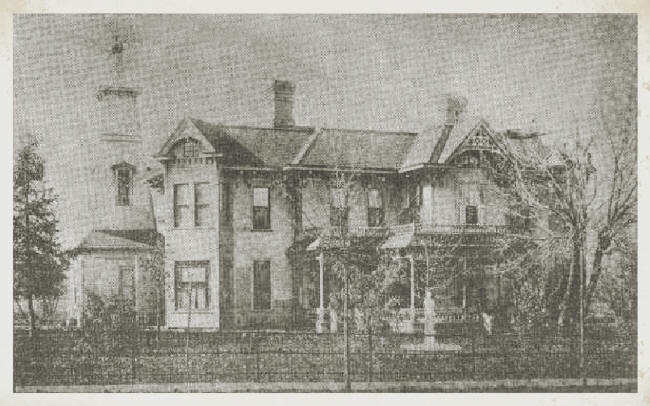
The now, Tuft’s museum house, was originally built by Emery Bruley, who erected the first portion, the northern end of the structure.
(Photos courtesy of Hilbert Naedler & Clark Co. Historical Society)
(Clark County Press, Good Old Days, December 30, 1993
1906 Emery Bruley has brought his automobile from Milwaukee and it is now affording pleasure to family and friends. Clark County Press, Good Old Days, September 27, 2006
1906 Jerry Bridge has traded his house and lot on Grand Avenue for Emery Bruley’s equity in the Bruley residence on Eighth Street, and is now running a boarding house there. Clark County Press, Good Old Days, July 12, 2006
1909 Emery Bruley is selling the following items, for less than their value:
Three houses on lots in Neillsville; 360 acres of good Clark County land; 30 city lots in Neillsville, next to the post office; controlling interest in the Bruley Fence Post Co. If interested, inquire of owner. Clark County Press, Good Old Days, September 15, 1999
1910 Neillsville has a very efficient fire department and the way they went after the fire in Emery Bruley’s store on Friday night was quite reassuring. They poured water into the building in long lengths and soaked the clothing up in great amounts. Where Emery had quite a considerable stock of men’s wool serge suits, he has now a large assortment of boy’s suits. Clark County Press, Good Old Days, May 3, 2000
1911 Neillsville’s automobile squad is being augmented almost every week and there are now 27 cars in our city. Several more people are getting the "car bug," so the count will be steadily rising. The new owners of cars and the makes of cars are as follows:
L. H. Howard, a Flanders and a Ford; Ed Schoengarth, Buick; Chas. Cornelius, Cadillac; Dr. Brooks, Buick; F. D. Calway, Cadillac; C. R. Sturdevant, Reo; J. A. Phillips, a Reo and a Cartercar; G. E. Grow, E.M.F.; F. W. Schultz, Ford; A. B. Marsh, Buick; Gilbert Johnson, Buick; Mrs. MacMillian, not known; W. L. Smith, E.M.F.; W. J. Rush, Ford; C. Krumrey, Buick; S. M. Marsh, E.M.F.; Chas. Decker, International; R. W. Balch, Maxwell; Dr. Leason, Reo; C. Rabenstein, not known; E. M. Holden, not known; Herman North, Buick; P. N. Nelson, Buick; E. Bruley, Franklin; R. F. Kountz, a Stanley and an Oldsmobile. Clark County Press, Good Old Days, June 27, 2001
1917 The Bruley elevator has a large carload of binder twine on order, to be here soon. The prices will be right. They also have a bargain price on flour. Clark County Press, Good Old Days, June 13, 2007
1917 CLARK COUNTY REPUBLICAN & PRESS (Neillsville, Wis.) 05/31/1917
Bruley, Ruth L. (Marriage - 24 MAY 1917)
Mr. Winford Dittmer of Kaukauna and Miss Ruth L. Bruley of this city (Neillsville, Clark County, Wis.) were quietly married Thursday morning, May 24, 1917, at the Catholic Parsonage in this city, Rev. Peter Weber officiating. After the ceremony a fine wedding breakfast was served at the home of the bride's parents, Mr. and Mrs. Emery Bruley, only relatives and a few near friends of the bride and groom being present. The young couple too the 11:30 train for a trip to Chicago and Milwaukee, after which they will return to Kaukauna, where the groom has his home furnished and ready to begin housekeeping.
The bride is one of Neillsville, Clark County, Wisconsin's choicest young ladies. She was born and brought up here, made a fine school record, graduating from high school in the class of 1909. She graduated later from Oshkosh Norman and taught with marked success in Wausau and Appleton. For the past two years she has been (an) assistant in the County Training School at Kaukauna, where her work has also met with high approval. From childhood her sweet disposition and rare personal beauty have made her a favorite with all who know her here, and these qualities, coupled with her intelligence and efficiency in her work, have made her a wide circle of friends in the state.
The groom was brought up at Seymour, Wis., where his mother still resides. After finishing his high school course he attended the University at Madison, graduating from the Law Department two years ago. He began practice at Kaukauna, and is now the city attorney of that place. He is a stranger to most of our people here, but is a young man of fine appearance, and highly spoken of by all who know him.
We join in wishing them abundant success and happiness.
••••••
1922 Neillsville Press (Neillsville, Clark County, Wis.) Thursday, 11/30/1922
--Bruley, Marie (? 30 Nov. 1922)
To Marry Today
Mrs. Emery Bruley went to Ladysmith Monday evening to be present at the marriage of her daughter, Miss Marie, to Mr. Wm. Bracken. The wedding is to be held Thanksgiving Day and will be attended only by the immediate relatives of the young people. After a short wedding trip they will go to Beloit to make their home. The groom is spoken of as a very fine young man, holding a responsible position with the Wisconsin Electric Co. at Beloit. The bride is a daughter of Mr. and Mrs. Emery Bruley, was born and raised here and graduated from Neillsville School. She is a young lady of exceptional ability and attainments and possessed of most pleasing personality. The bride has a host of friends here who tender their very sincere congratulations.
•••••••••
The 1881 History of Clark Co. WI
EMERY BRULEY, merchant, Neillsville, born in Ottawa City, Canada, July 4, 1845, in 1868, went to Minneapolis, Minn., and afterwards to La Crosse, where he met Mr. Stafford and came up with him to Staffordsville, in Y, 1868. Came to Neillsville and started a blacksmith shop, which he run for nine years, then opened a clothing store, and now carries a stock of $9,000, and does a business of $25,600 a year. In September 1864, he married Miss Philomena Beauchamp of Ottawa City. He belongs to the A. O. U. W. The 1881 History of Clark Co. WI
••••••••••
Contributors
Barbara Benware Burt, Dolores (Mohr) Kenyon
|
© Every submission is protected by the Digital Millennium Copyright Act of 1998.
Show your appreciation of this freely provided information by not copying it to any other site without our permission.
Become a Clark County History Buff
|
|
A site created and
maintained by the Clark County History Buffs
Webmasters: Leon Konieczny, Tanya Paschke, Janet & Stan Schwarze, James W. Sternitzky,
|
